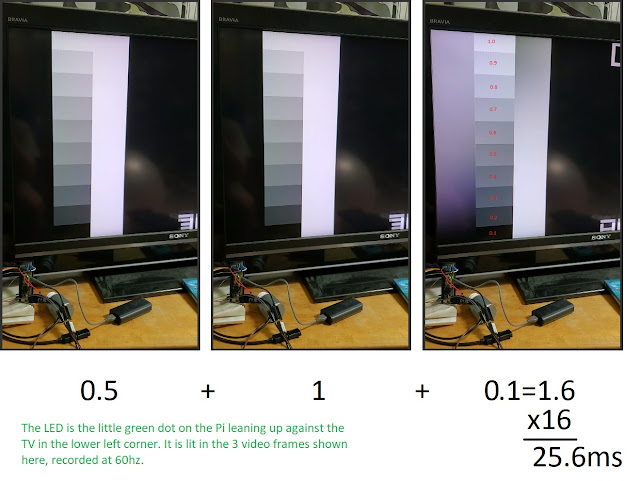LG 42PT350 review: input lag, deinterlacing and upscaling using the piLagTesterPRO
This 720p Plasma TV from 2012 is rather mediocre, with aliasing even at 720p, not to mention 480p, and some of the worst lag I've seen. It does have very good response time and good looking motion, and the deinterlacing is good, making it a decent non-gamer TV.
Image quality
Good upscaling is critical for retro gaming. Ideally, all pixels should appear equally sharp and bright (no aliasing), and angled lines should appear smooth, with no jagged, irregular steps. Also important is that the display shows most or all of the pixels it is sent. Often, this is not the case, with some number of pixels cropped from the bottom or top edges. Shockingly, these tests are relevant for modern gaming as well, because even at their native resolution many TVs have aliasing and cropping.
I attempted to adjust the set to minimize cropping and aliasing. The true resolution of the screen is 1024x768, which means all the standard video modes have cropping and aliasing problems. Increased cropping sometimes hurt and sometimes helped the aliasing, but except for the true native resolution all modes suffered from noticeable aliasing. Why in the world did they target a resolution which 99% of their users would never use!? That said, when viewing natural images the screen looked great, it's only with pixel art that the aliasing issues become obvious.
| resolution | aliasing, jaggies | cropping (side, top) |
| 480p/i | B- | 25 pixels l/r, 20 t/b |
| 720p | B- | no crop if in "just scan" |
| 1080p | C+ Bad aliasing and very jagged lines | no crop if in "just scan" |
| 1024x768 | none | none |
The display has 3 HDMI, 1 VGA, and 2 yPbPr input. I only tested HDMI.
This TV supports 24hz at 1080p; and it really draws at 24hz with no dropped frames or temporal distortion, so it should be good for movies. It's maximum refresh rate for TV modes is 60hz; if you switch it to computer modes it can accept a 75hz signal for some sub-native resolutions. This does not improve lag, however, as the TV continues to draw at 60hz, and just drops all the extra frames.
Input Lag
I used a piLagTesterPRO to measure input lag. This device sends a frame of video over HDMI and measures how long it takes to display it. This display does not have a game mode; just a game 'color' preset that does not impact lag at all. I toggled all the display quality settings and did not see a consistent effect on lag, however the tests reported are with every "enhancement" set to off.
Input Lag Test Results
I report two kinds of values. 1st response measures how long it takes for the TV to start responding (I use a 5% change in display brightness). This overly optimistic value doesn't tell how long it takes to see anything useful, but matches what other reviewers call input lag. full response is a more realistic measure of lag, and requires the display to reach 80% of full brightness. This combines both input lag and response time, and is closer to what you would actually experience in a game.
All progressive modes were the same: slow(!) taking 63ms start rendering the screen. The only good thing is that the screen is rendered simultaneously top and bottom, so there's no waiting for the scan out. This is common for plasma displays: pixels at the top and bottom of the screen are drawn at the same time, unlike a standard LCD where the pixels at the top are drawn first and the pixels at the bottom are drawn up to 16ms later.
Deinterlacing took 17ms. The deinterlacing quality was good.
Response time was excellent, at 4 ms it was very fast, and completely consistent no matter how big or small the change. Motion looks great on this set. Shame about the high lag.
The TV does not support 960p so this isn't a great set for OSSC, but you'd only save 17ms by switching to bob deinterlacing, so not much of a loss, and it's far from obvious that it would do a better job upscaling at 960p.
Results compared to other displays
To allow quick comparison between many displays I've summarized the results
across all the displays I've personally tested with the piLagTester Pro. Min
lag is the time to the first response, measured where the screen starts
drawing (typically, the top); real lag is the time to the full response,
measured where drawing finishes (usually the screen bottom), i.e. input lag +
scan out + response time. Numbers in red denote average values that can vary by
up to 8ms between power cycles.
This list is sorted by real lag for each display's native resolution and max
refresh rate (usually 1080p60 but some sets are 720p60, and other monitors
support > 60hz). Since this TV scans out instantly, it has a 16ms head
start on the "real lag" metric compared to many of the TVs on this list. But even with that advantage, it's near
the bottom. In terms of lag this TV is really bad. This would be a poor choice
for any gamer.
Other models (to avoid)
I tested the LG 42PT350, which is the 42" version. The manual for this TV lists a huge number of TV models, but based on the identical power consumption and/or the tail part of the model number I'm guessing these might perform similarly: 42PT330 42PT350C 50PT330 50PT350 50PT350C. However, I've made no efforts to check the rest of their specs so that's only a quick guess. Given how bad this TV is, however, I'd avoid taking the risk even based on a lose guess like mine.




Comments